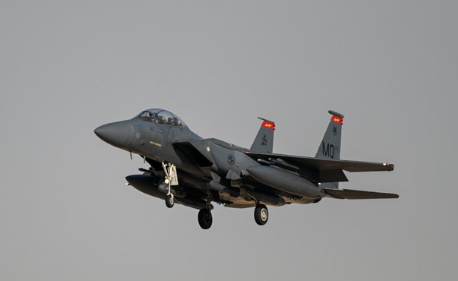|
Getting your Trinity Audio player ready...
|
Edited by: Fern Sidman
In a significant show of military strength and readiness, two groups of F-15E “Strike Eagle” multirole fighters from the 389th Expeditionary Fighter Squadron arrived in the Middle East this past Wednesday. According to published reports, these fighters, based out of Mountain Home Air Force Base in Idaho, flew in from RAF Lakenheath in the United Kingdom, marking the latest deployment in response to escalating tensions between Israel and Iran. The arrival of the F-15Es highlights the increasing military buildup in the region as concerns grow over the potential for a broader conflict.
The deployment of the F-15E Strike Eagles follows the recent stationing of a squadron of A-10C Thunderbolt II aircraft in the region, which arrived last week as part of ongoing efforts to bolster U.S. military capabilities. These A-10Cs, renowned for their ground-attack prowess, signal the Pentagon’s intention to be prepared for a wide range of operational scenarios, including air support for ground forces. According to military sources, the Pentagon is currently weighing further reinforcements, with additional squadrons of F-16C Fighting Falcons and F-22 Raptors expected to arrive within the coming week, further expanding the U.S. air presence in the region.
Two Groups of 4 F-15E “Strike Eagle” Multirole Fighters with the 389th Expeditionary Fighter Squadron from Mountain Home Air Force Base in Idaho, arrived in the Middle East on Wednesday, after flying from RAF Lakenheath. Their Deployment to the Region follows an Escalation in… pic.twitter.com/u1huHnwpFQ
— The Jewish Voice (@TJVNEWS) October 10, 2024
The deployment of the F-15E Strike Eagles, known for their versatility in air-to-air and air-to-ground missions, is particularly notable due to their ability to engage a wide range of threats. Equipped with advanced avionics, precision-guided munitions, and robust electronic warfare capabilities, these aircraft are well-suited for conducting strikes against a variety of targets, including hostile air defenses and key military infrastructure. Their arrival signals Washington’s readiness to support its allies and protect U.S. interests should tensions continue to escalate between Israel and Iran.
Alongside the aircraft deployments, several thousand U.S. airmen and other military personnel have been stationed in the region. These forces provide vital support for the air operations, including logistics, intelligence, and maintenance, as preparations continue for what could become a significant regional conflict. The Pentagon has indicated that it is closely monitoring the situation, with officials weighing additional deployments as necessary to deter aggression or respond to any direct threats.
F-15 機動飛行 ④
アレスティングフック出てるのはなぜ?🤔 pic.twitter.com/pf6mEgKUqv— 随竹庵 (@nEAuKtaYMb39386) October 6, 2024
This military buildup comes at a time of heightened anxiety in the Middle East. Iran’s influence in the region, particularly through its support of Iranian-backed terrorist groups such as Hezbollah, has long been a point of tension for Israel, which views Tehran’s growing regional power as an existential threat. Recent escalations, including military skirmishes and hostile rhetoric, have raised concerns about the possibility of a broader conflict between Israel and Iran, potentially drawing in other regional actors and global powers.
For the United States, these deployments are aimed at sending a clear signal of deterrence while also preparing for the possibility of direct military engagement. The presence of U.S. F-22 Raptors, considered one of the most advanced air superiority fighters in the world, underscores the seriousness with which the U.S. military views the current threat environment. The F-22, with its stealth capabilities and unparalleled agility, would play a critical role in any potential conflict by establishing air dominance and neutralizing advanced enemy air defenses.
🇺🇲 U.S. Central Command:
⭕️ U.S. Air Force F-16 Fighting Falcon takes off in support of operations within the U.S. Central Command area of responsibility.
⭕️ U.S. Air Force F-15E Strike Eagles from the 389th Fighter Squadron, Mountain Home Air Force Base, Idaho, arrive in the… pic.twitter.com/Jdji0nalTF
— LevantOSINT (@LevantOSINT) October 10, 2024
The Pentagon’s decision to bolster its forces in the Middle East reflects concerns over the rapidly changing dynamics in the region. While diplomatic efforts to de-escalate tensions are ongoing, the U.S. military’s presence provides a critical backstop, ensuring that American forces are ready to respond swiftly and decisively to any outbreak of hostilities. In the coming weeks, the arrival of additional squadrons, coupled with the already-deployed aircraft, will significantly enhance U.S. operational flexibility, enabling a range of tactical options should conflict become unavoidable.





